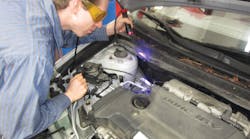Q: Should I hold off on buying an identifier because of the new refrigerant coming out?
A: First, Neutronics does make an A/C identifier that can detect for impurities in R1234yf refrigerant. However, being that practically nothing you work on will have that refrigerant for years, you should not hold off on getting an identifier. Every single 30-lb container of refrigerant should be tested soon after you buy it. There are counterfeit bottles of R134a out there, because of the wide availability of R12 and other gases which are cheaper to substitute for R134a overseas. And, because not every shop is going to be so careful checking their stock, you have to test every vehicle for A/C contamination that you have not exclusively worked on the A/C.
However, there's another good reason why you should not worry about R1234yf, at least not yet. R1234yf will not contaminate a R134a system that badly, or vice versa. Unlike R12 contamination which essentially renders you're A/C equipment useless, R134a/R1234yf are essentially mixable. Their mixture leads to about a 10 percent decline in cooling efficiency. In other words, it's not that noticeable and with the price of R1234yf about 20 times higher than R134a as of present it does not take a weatherman to tell you which way the wind is blowing with this one.
Q: I can't find dye anywhere even after injecting it in the system, but I don't want to condemn the evaporator too quickly. What should I do?
A: This is a real tough one, and there is no perfect method. Most of us rely on the process of elimination (i.e.: "It's not leaking where I can see it, so it must be leaking where I can't see it!"). (See Fig. 1.)
However, there are a couple strategies you can try. Try removing the cabin air filter or blower motor in order to get a black light and visually inspect the evaporator. An A/C sniffer might also help. Another method is removing the core from the Schrader valve and putting CO2 gas into the A/C system. Then, stick an emissions analyzer in the vicinity of the evaporator. If CO2 levels escalate, you nailed an evaporator leak. However, CO2 might not be detected if you need real-world system pressures to force a leak. It's an imperfect method, but it's another bullet in the gun belt so to say.
Q: What special equipment do I need to deal with sealant?
A: First, you do not want to get your A/C machine contaminated with sealant. It will cost you too much to have your machine down in the middle of A/C season. Every single vehicle before you service it needs to be checked for sealant.
Think about it. Your parts store sells the stuff. Do-It-Yourselfers use the stuff. Shops use the stuff! There are too many people out there adding sealant to vehicles to avoid expensive A/C repairs. Because of this, you need to take a few extra minutes every A/C job to test for sealant. (See Figs. 2 and 3.)
When you find sealant, you need to charge your customer to remove it from the vehicle. An A/C sealant filter can separate all the harmful sealant from the R134a, but this equipment is not cheap and needs to have its filters changed every 50 hours of use or so (See Fig. 4). Then, after removing the sealant, recharge the system with dye. Chances are that sealant was added to that system because there was a leak somewhere in the past.
As a side note, it should be said that there are new sealants out there that meet the SAE 2670 standard that are not supposed to harm the A/C system or any service equipment. These sealants can get pricey (about $15 an ounce) and may pose their own benefits and issues. If using such sealant, be sure to explain to your customer the benefits and also risks involved in using a sealant.
Q: What special equipment do I need to work on hybrids?
A: To work on hybrids you either need a separate A/C machine or a PAG oil filtering element (see Fig. 4, again). The filtering element prevents PAG that is inside your A/C machine from getting in the hybrid.
Regardless of what you might have heard, hybrids should not have PAG oil as a lubricant. They should have a non-conductive POE oil certified for hybrids. Furthermore, they should not have regular A/C dye, but rather hybrid-compatible dye.
Why? Hybrids have electric compressors. This is because their gasoline motors shut off when the vehicle idles. If the compressor was belt-driven, as can be found on every other vehicle, this would result in the driver having hot air blown in his face. The windings inside electric compressors break down when exposed to PAG, and worse yet, PAG is conductive. So, for safety's sake be careful to use the specified POE and dye.
Q: I believe that the compressor is bad, but I cannot rule out a bad expansion valve. I can command the A/C compressor clutch on and off with my Power Probe. Is there anything I can do other than changing both?
A: Infrared thermal imaging technology shows some real promise in finding leaks and parasitic draws, because it can view differences of temperature and essentially "see through walls" so to say. With an understanding of A/C system pressures, accurately seeing temperature differences can really hone in our diagnosis. (See Figs. 5, 6 and 7.)
Let's get this straight: The refrigerant entering the compressor should be cool, and it should be hot leaving the unit. Refrigerant then is cooled going through the condenser, but still hot. This temperature should remain about the same until it hits the receiver dryer. A restriction should lead to a large temperature difference. The expansion valve should have a large temperature difference in normal operation, because cool refrigerant should be leavening it. When using a pressure gauge a restriction in the receiver drier or expansion valve should have very high pressures on the high side, and low pressures on the low side. Sealant clogging up the condenser can also cause a restriction, with the same results as a clogged receiver drier or expansion valve as reflected in system pressures.
Thermal imaging helps because it helps us see where the restriction is. If you have a normal operating receiver drier, but the expansion valve shows little heat difference, pressures will tell you if the compressor is still pumping pressure into the system and all you need is the exansion valve.
You can use a temperature gun to employ this strategy on an A/C system, but you have to be very careful with your aim. For example, the temperature of the cooling fins on a condenser is much different than the hot pipes beneath.
Thermal imaging or having very good aim with a temperature gun is more useful in finding partial blockages than complete blockages. A complete blockage makes it can be very hard to figure out whether the compressor is dead in the water or something else is rendering it useless, simply because if refrigerant flow is stopped pressures are affected universally. That's why no job should be under warranty unless the expansion valve and receiver dryer are replaced. A shop should not take liability over things that are not testable to a degree of 100 percent accuracy. There will always be a gray area with A/C, and a customer should understand that.




